Adjusting toe alignment on wheels
The Video Course teaches you everything about modern cars.
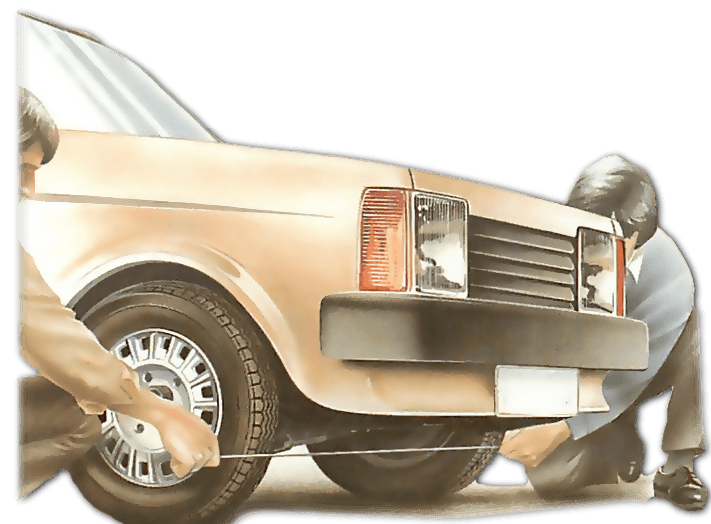
Front wheels wrongly aligned cause uneven tyre wear and may seriously affect the car's handling.
Toe-in or toe-out - the amount by which the wheels are closer or further apart at their front edges than at their rear edges - is adjustable on all cars.
The setting can go wrong because of an incorrect adjustment, or through driving hard on to a kerb.
Camber - the angle at which a wheel leans in or out - is not normally adjustable. But if you find that it is different on the two sides of the car, something is wrong with the tyres, wheels or suspension. Check them (See Checking suspension joints and pivots ).
The amount of toe-in or toe-out is very small - typically 0.3 to 1.6 mm - and must be set by a garage with special equipment. But you can make a rough adjustment by altering track-rod lengths.
To roughly check toe setting, use a length of string, preferably, or new, unkinked electrical wire.
Camber, too, can be checked only approximately, because the sidewall of a modern radial-ply tyre always bulges outwards slightly in the area where the tyre contacts the ground . Most car wheels lean out at the top, so deviation from the vertical is measured at the bottom.
If you suspect from irregular tyre wear (See Checking for wheel and tyre damage ) that something is wrong, check both the toe settings and the camber to make sure the car is drivable.
Adjust the toe setting if necessary so that you can safely drive the car to a garage for expert attention.
Check the toe setting if you have dismantled and reassembled any part of the track or tie rods , and again have a garage re-check it.
Checking toe setting
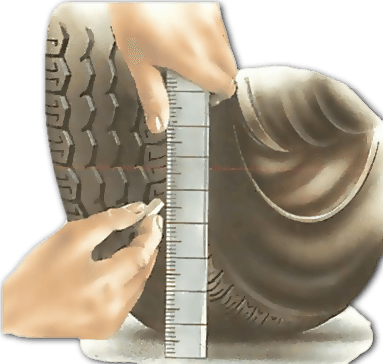
Remove any heavy loads from the car. Inflate all tyres to the right pressures . Check the steering and suspension joints for wear (See ).
Make sure that the track rods are straight and the same length on both sides.
This does not apply to those VWs and Audis with one adjustable and one fixed track rod (See Replacing other types of track rod ).
Place the car on a flat, even surface — not a road, which is cambered — and centre the steering. Push the car forward a few yards, letting it stop without using the brakes .
Bounce it a few times to settle the suspension. After this, do not touch the steering wheel or get in the car.
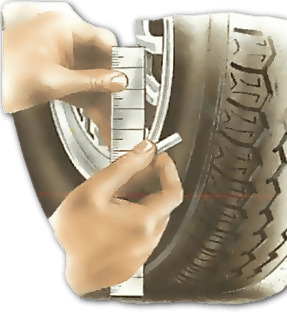
Find measuring points on each front wheel. The car handbook usually gives the toe setting as measured between the inner wheel rims at their front and rear edges at the level of the hub .
There are, however, few cars on which you can stretch a string or wire straight between these points because the axle is in the way. Measuring between the edges of the tyre treads is not usually practicable because the tread often has no clear edge.
Therefore measure from one outer wheel rim to the other. A wire check cannot be truly accurate, so it does not matter too much that you are not measuring from the 'right' points.
All you can establish is whether the wheels have a slight toe-in or toe-out — not exactly how much the measurement is.

Stretch the wire round the tyres as close to the height of the hub centre as possible, and pull it taut at both front and rear.
Mark this level on the tyres with chalk and a ruler.
Mark the wire near one end, then get a helper to hold the mark on one measuring point and take the wire over to the other.
Pull it taut and mark the wire where it touches the second measuring point.
Repeat the process at the rear of the wheel, trying to keep the same tension on the wire. The distance between the first and second marks on the wire is double the toe-in or toe-out.
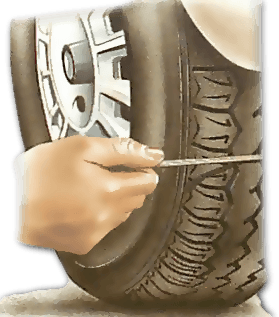
Double check by rolling the car forward so that the wheels make half a turn, bounce the car and repeat the whole test.
Checking the camber
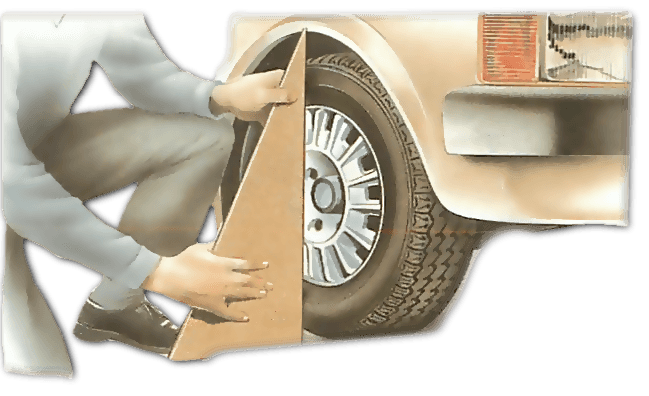
Prepare the car in the same way as for the toe-in check.
The ideal measuring tool for a camber check is a builder's square, but anything with a perfect right-angle will do - such as a piece of hardboard.
Hardboard or card is best for wheels and protruding hubs, as you can cut a piece out to set the edge against the sidewalls.
One side of the card should be as long as the full height of the wheel, the side at the right-angles to it as least half that height.
Set the card against the wheel, upright and central, so that the long side touches the sidewall in the two places and the other side is square to the ground. If necessary remove the hub cap or cut a piece out of the card.
There will be a gap between card and tyre, probably at the top. Measure the gap.
Repeat at the other wheel. The two measurements should be the same. Move the car forward so that the wheels make half a turn, bounce it and repeat the test.
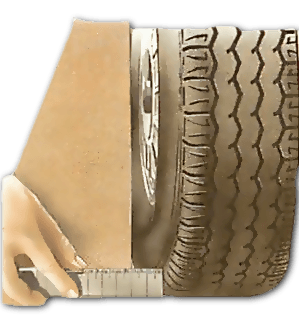
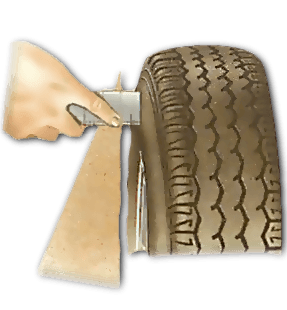
The camber is not normally adjustable, so if the measurements are substantially different, the tyres, wheels or suspension may be distorted. Distorted wheels or tyres should be replaced.
Adjusting toe-in and toe-out
Toe-in and toe-out adjustments are made by screwing the track-rod ball-joint ends up or down the track rods to alter their length.
It is not possible to make totally accurate adjustments at home without proper wheel-aligning equipment. But the measurements obtained by the wire method already outlined should enable you to adjust the settings accurately enough to drive to a garage for expert attention. Few cars have a toe-in or toe-out of more than 3 mm, so try to adjust to within that measurement if possible.
It is not necessary to disconnect the t rack rods; the inner ends of the track rods turn freely on their ball joints at the ends of the rack as you turn the rods to adjust their outer ends.
Adjust both rods by equal amounts, except on VWs and Audis, which have only one adjustable rod to alter their steering. Even when the fixed rod has been replaced with an adjustable exchange part, the steering is still adjusted by altering a single rod.
You may be able to adjust the track rods without raising the front of the car. This saves time and labour, since you have to check the toe setting each time you have to make a trial adjustment and this must be done with the wheels on the ground.
But on some cars you may have to remove the wheels to gain access to the ball-joint locknuts.
If you have to raise the car and work under it, use ramps (or axle stands if you have to remove the wheels) not jacks.
Apply the handbrake firmly, and chock behind the rear wheels.
Adjusting the track rod
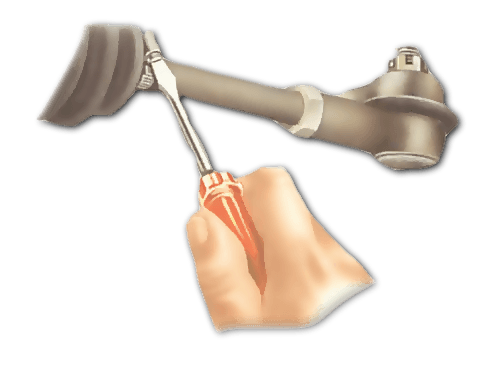
Loosen the clips at the outer end of the rack gaiters on a rack-and-pinion steering. Make sure each gaiter can turn freely on the track rod, but do not push it up or down: its exact placing is important.
Hold one track-rod ball joint with self-locking grips to stop it from turning, which would damage it. Unscrew its locknut two or three turns.
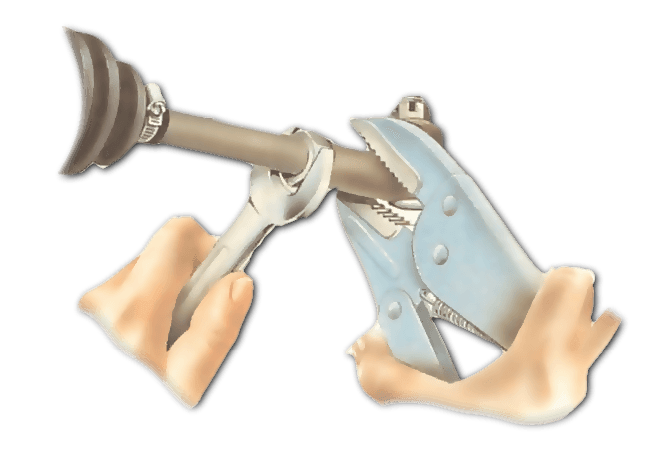
One rod may have a left-hand thread: look carefully before unscrewing and standard bolt if you are not sure.
Standard bolts have a right-hand thread: turning a nut clockwise shortens the distance between the nut and bolt head; turning it anticlockwise lengthens the distance. A left-hand threaded bolt works in the opposite way.
Cars with steering-box systems have ball joints at both track-rod ends. Slacken both locknuts. One on each rod always has a left-hand thread.
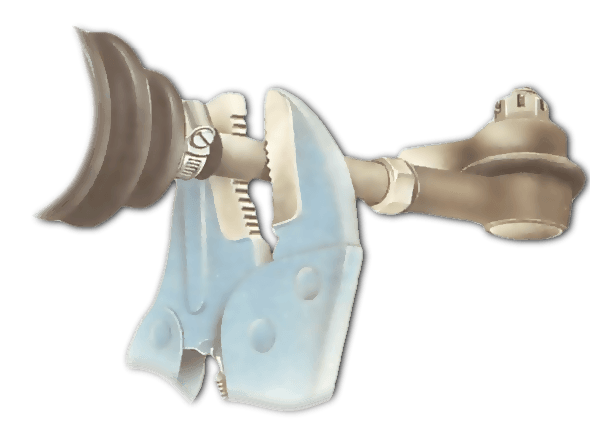
Turn the track rod with self-locking grips to lengthen or shorten it. Some rods have flats which can be gripped by a spanner.
Which way you turn the rod depends on the thread. Check before you turn. Give both rods half a turn, then remeasure the toe setting. Readjust and retest until you are satisfied.
Some track rods have a short sleeve with a right-handed thread at one end, and a left-handed thread at the other. The sleeve connects the two halves of the rod. Turning the sleeve alters the length of the rod.
Ensure that the ball-joint stud is in the middle of its travel, so that the joint can move freely on the steering arm . Grip the joint and tighten the locknut.
Straighten the rack gaiters, taking care not to alter their position on the track rod, and tighten their clips. On steering-box systems, tighten the inner ball-joint locknuts.
Adjusting a two-piece track rod
Many classic Renaults have two-piece track rods. The inner section screws directly into the rack end, and has a locknut outside or inside the rack gaiter.
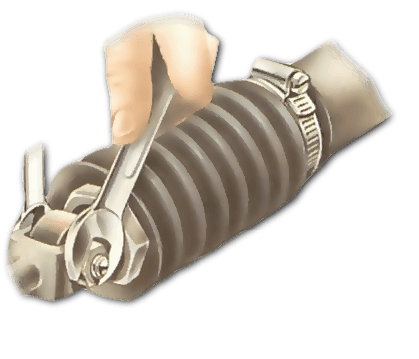
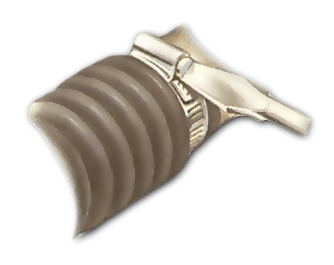
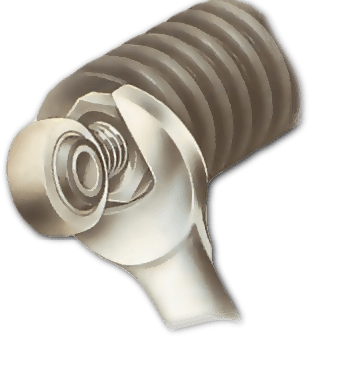
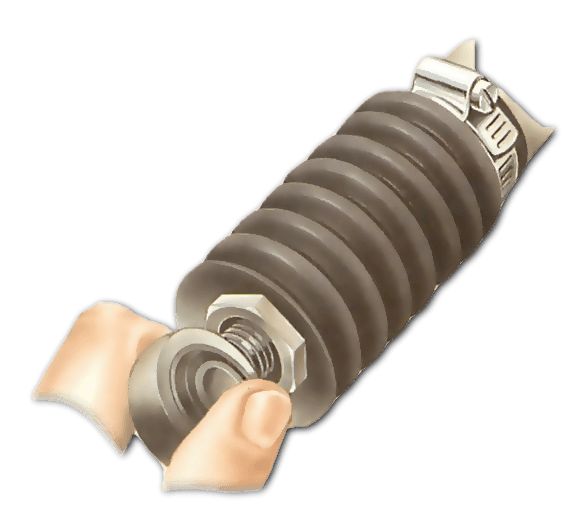
If you find your car has an adjustable outer track rod, adjust this as normal, do not try to adjust the inner rod which in this case is fixed.
Separate the two halves of the road by removing the bolt. Loosen the inner gaiter clip so that the whole gaiter can turn. Or push the gaiter off the edge of the locknut plate .
Slacken the locknut, screw both inner track rods in or out in exact half turns - the bushed eye on the end of the track rod must stay vertical.
Reconnect the outer track rods and test the toe-out, or toe-in, as outlined previously.
The Ultimate Car Mechanics video course
Learn everything about modern cars from our new video series.
Learn more >-
We build a Mazda MX5 Miata from scratch
We start by tearing down and then rebuilding the whole car.
-
Every part explained
There's ridiculous detail on every part. Clearly and easily explained.
-
All modeled in 3D
We've created the most detailed 3D model ever produced so we can show you everything working.






